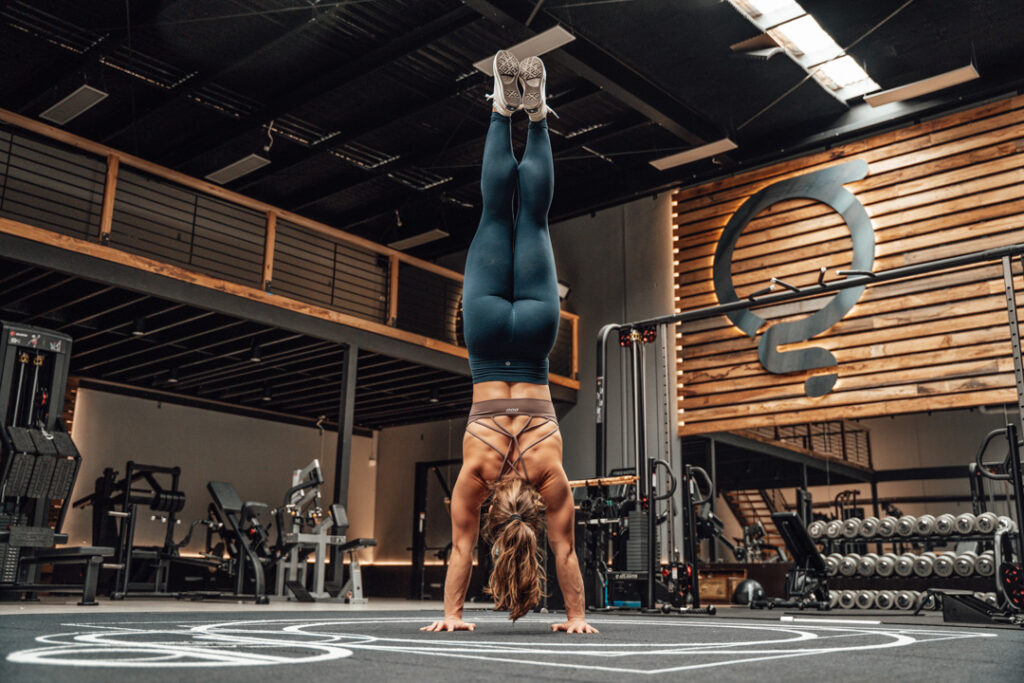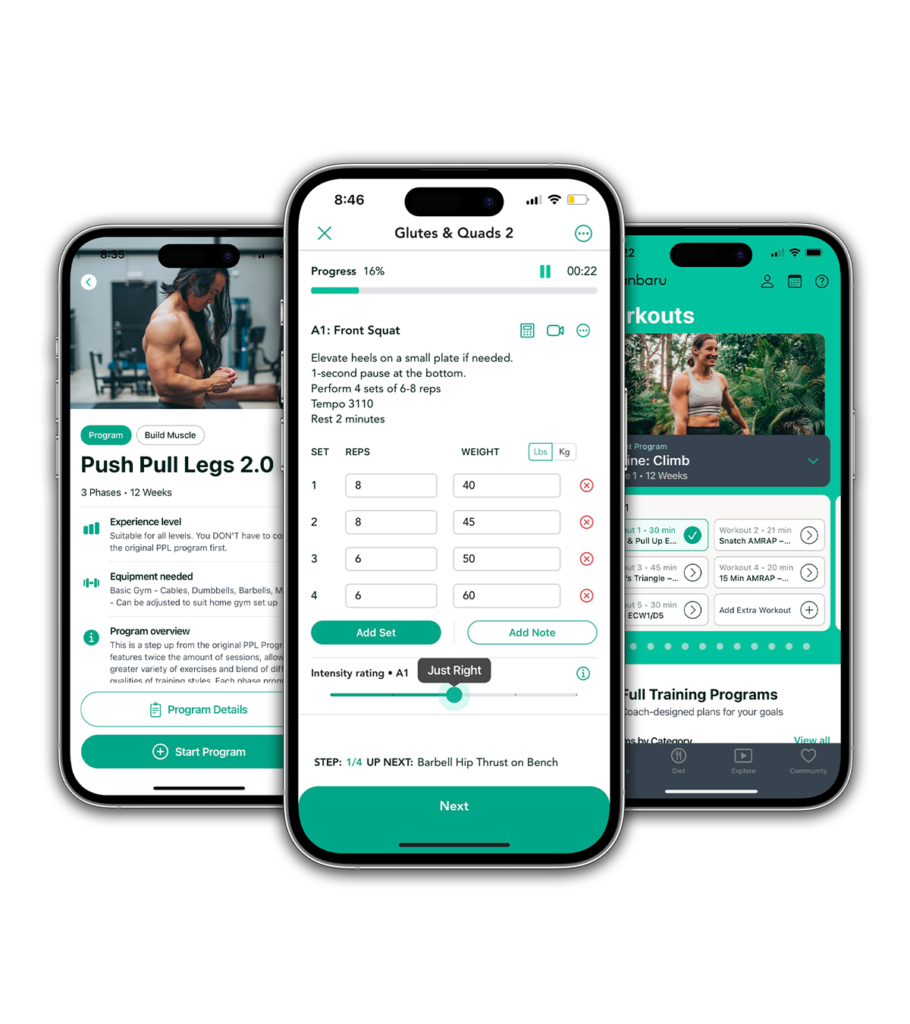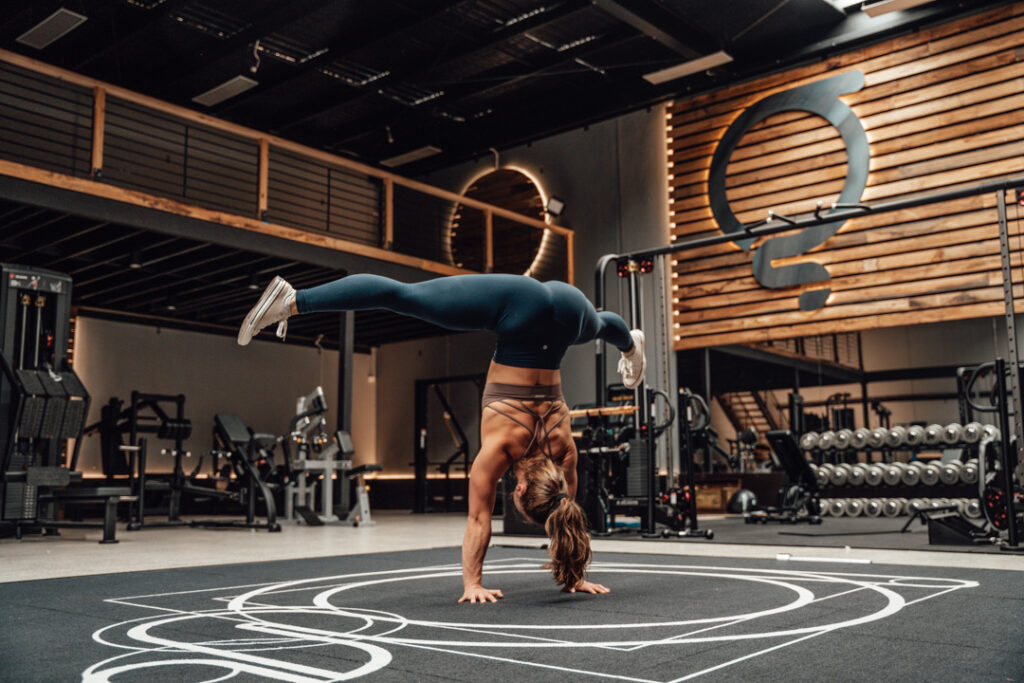Petr, 34, is an executive chef, husband, and father of a toddler. This is how he got his fitness back on track.

Most early handstand drills start on the wall – because we need help with the balance component at first. One of the mistakes beginners make with this is letting the wall take a lot of their weight. These drills will help you feel what it’s like to shift your weight into your hands instead of the wall.
Do them with the intention of putting as little weight into the wall as you can, using the wall gently for balance only.
Handstand Hold on Wall
Technique
Kick up to a handstand on the wall. Focus on the following:
- Pushing into the floor to get as tall as you can, and open the shoulder as much as you can
- Gently squeeze the glutes and pull the ribs down toward your belt line to avoid letting the lower back extend. Only your heels should be on the wall
- Grip the ground by pushing your fingertips into the floor
- Shift your body weight over your hands instead of letting it rest into the wall. Touch the wall as lightly as you possibly can.
Common Mistakes
- Letting the low back sag and form the “banana back” position.
- Letting the butt or legs touch the wall
- Letting the hands be lazy into the floor instead of gripping the ground to pull weight off the wall
- Relaxing into the shoulders and sinking down toward the floor
- Squeezing the abs too hard – this will take away from your ability to push into a strong shoulder position, unless you have very impressive shoulder mobility
Handstand Hold on Wall – chest to wall (wall facing)
Technique
The wall facing handstand on wall is harder to get into but is easier to keep a strong body line in. Use this opportunity to focus on keeping the ribs and belt line as close together as they can be without losing range in the shoulder. You do not need to squeeze your abs hard.
Make sure you stay as light on the wall as possible – the wall should not be doing the work!
Common Mistakes
- Relaxing into the shoulders and sinking down toward the floor
- Squeezing the abs too hard
- Letting the legs or stomach rest on the wall
- Letting the wall take your body weight
Handstand Hold Parallel to Wall
What is it?
A way to bridge the gap between free standing holds and holds on the wall. You can use one foot gently on the wall to correct slight over- and under-balances.
Technique
Kick up to a freestanding handstand next to a wall, with one shoulder near the wall. Let one foot reach out and catch the wall with your foot. Allow that foot to correct small tips in the wrong direction with your balance – it won’t be enough for major deviations from the balance point but it will help if you wobble a little!
Wall Pull Aways (heel pulls)
What is it?
A movement where you pull yourself from a handstand on the wall and briefly leave the wall to hold off the wall. You can either do these for reps falling back to the wall, or do more aggressive pulls to build strength in the fingers that help to prevent overbalancing.
Technique
Kick up to handstand on the wall, placing your fingertips on the ground just over one hand-distance from the wall. Dig your fingertips into the ground hard enough to shift your bodyweight over your hands and allow the heels to gently pull off the wall at the same time. If you can, allow yourself to spend a second or two in that handstand as your heels peel off the wall before returning to the wall. Over time, build the duration up so that you can peel off the wall and hold for several seconds.
Chest to Wall Pull Aways (Toe Pulls)
What is it?
A movement where you drift your bodyweight over your hands from the wall until you are no longer touching the wall. You can use this to practice finding your balance on your hands in a handstand.
Technique
Wall walk, split or cartwheel your way into a wall-facing handstand, with the heel of your hand a little more than one hand-distance from the wall. Shift your shoulders and hips over your hands away from the wall, feeling your toes get light and the amount of pressure on the wall slowly reduce to zero. If you can, allow yourself to spend a second or two in that handstand before returning to the wall. Over time, build the duration up so that you can peel off the wall and hold for several seconds.
Handstand flutter
What is it?
A movement that allows you to experience brief moments in the handstand while switching the legs to allow for some support from the wall.
Technique
Kick up to a handstand on the wall, a little further away than usual but not far. Separate your legs until you feel the leading leg pull your body weight away from the wall into your hands. Slowly and gently switch which leg is on the wall, letting the legs cross over the middle so there is a brief moment where you are in a handstand.
Common mistakes
- Letting the feet slam into the wall – this should be a gentle switch of the feet
- Letting both feet be on the wall – we are trying to reduce your reliance on the wall with this drill
- Passive hands – you need to grip the ground to make this work
- Letting the low back sag – reach tall like you want your toes to touch the sky
Handstand flutter (chest to wall/wall facing)
What is it?
The same as the above, but facing the wall.
Technique
Wall walk, split or cartwheel your way into a wall-facing handstand, slightly further away from the wall than usual. Shift your shoulders and hips over your hands away from the wall by separating your legs. Slowly and gently switch which leg is on the wall, letting the legs cross over the middle so there is a brief moment where you are in a handstand.
Common mistakes
- Letting the feet slam into the wall – this should be a gentle switch of the feet
- Letting both feet be on the wall – we are trying to reduce your reliance on the wall with this drill
- Passive hands – you need to grip the ground to make this work
- Letting the low back sag – reach tall like you want your toes to touch the sky

Ready to workout?
Follow proven programs written by expert coaches, delivered in an easy-to-use app built by lifters, for lifters.
Related Posts
10 tips for more leg strength and size
5 tips for better back gains
Squat stronger with this 1 simple tip

Getting strong enough to spend minutes in a handstand requires spending a lot of time on your hands! But not all of that will happen upside down right away. We can regress straight arm strength training and make it more fun by mixing up positions and adding in other sources of challenge.
Plank to Down Dog
What is it?
The friendliest, easiest movement to start moving your shoulders from a plank into a more handstand-type postion.
Technique
Shift from a high plank position into a pike or downward dog position. Think about pressing into the floor and keeping your neck long.
Common Mistakes
There’s no need to extend your back excessively here – that’s not a position we will need in a handstand. Keep your ribs pulled down toward your pelvis like you’re doing a very small crunch and let the shoulders do the work.
Box Plank Around The World
What is it?
An easy way to accumulate lots of time with your weight through your hands and shoulders.
What You’ll Need
A 20″ x 24″ x 30″ box.
Technique
Set yourself up in a strong plank (no saggy spines!) on a box. Keep your feet in one place, and walk your hands around the box for as many reps as is prescribed.
Box Plank to Pike
What is it?
An early way to expose you to moving from a horizontal position to a stacked, hips over hands position, while still working on straight arm strength. Try to go as close to the box as you can – you want to walk your hands so close to the box you almost feel like you’re going to fall over the top.
What You’ll Need
A 20″ x 24″ x 30″ box.
Technique
With your feet on a box, walk from a high plank to a pike position (hips stacked over hands). Don’t worry if you have to bend your knees, hips over hands is more important than straight legs.
Common Mistakes
Not walking all the way in. Film yourself from the side if you need to check that you are walking close enough. You should be able to draw a vertical line from your hip to the floor and that line should draw through the middle of your hands (not the heel of your hands).
Lateral Plank Walk Over Plate to Box Wall Walk in Pike
What is it?
In a high plank, walking the hands back and forth over a bumper plate then walking into a pike position.
What You’ll Need
A 20″ x 24″ x 30″ box and a 10-20kg bumper plate.
Technique
Make sure to keep a tight body line and walk all the way into your pike position so your hips are over your hands.
Pike Around The World
What is it?
In a pike position, walking your hands around a box to accumulate time upside down on your hands. It’s not a flexibility contest, so don’t worry if you need a higher box or if you need to bend your knees.
What You’ll Need
A 20″ x 24″ x 30″ box.
Technique
Walk from a plank with your feet on a box to a pike. Then walk your hands around the box in a circle, keeping your hips stacked over your hands.
Handstand Up Downs
What is it?
A shoulder strength drill that forces you to push into the ground so you can step up onto a plate.
What You’ll Need
A wall and a 10-20kg bumper plate.
Technique
Place a bumper plate near a wall and kick up to handstand with your hands on either side of the plate. Step one hand up onto the plate, then the other. This will be a narrow shoulder position for some, do your best. Then step back down. That’s one rep! Keep going, it will get burny pretty quickly.
Common Mistakes
Letting the back sag instead of staying tall and upright in the handstand.
Handstand Up Downs C2W
What is it?
The same as the above, just facing the wall.
Technique
Place a bumper plate near a wall and wall walk or cartwheel into a wall-facing handstand with your hands on either side of the plate. Step your hands up and down onto the plate.
Common Mistakes
Putting too much weight into the wall – stay in your hands!

Ready to workout?
Follow proven programs written by expert coaches, delivered in an easy-to-use app built by lifters, for lifters.
Related Posts
10 tips for more leg strength and size
5 tips for better back gains
Squat stronger with this 1 simple tip
Bodyweight exercises are a versatile and effective way to build strength without the need for fancy equipment or a gym membership. In this blog post, we’ll dive deep into the world of bodyweight exercises, exploring their benefits, various exercises, and how to create a bodyweight workout routine that helps you reach your strength training goals.




